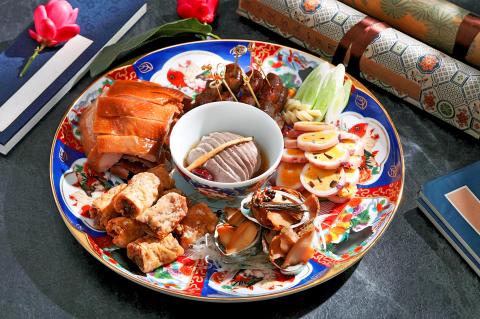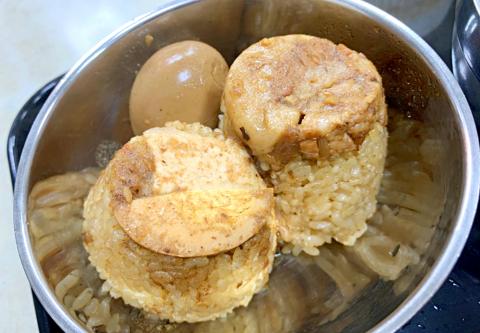The French Michelin Guide yesterday awarded stars to 24 establishments in its second restaurant guide to Taipei.
“Our inspectors were not only impressed by the standard of local Taiwanese cuisine, but also by the global influences being imported by the very talented and innovative local chefs, which together will no doubt entice food lovers from around the world,” said Gwendal Poullennec, International Director of the Michelin Guides.
Establishments like Tairroir (態芮) and Raw, prominent names that each received a star last year for thoughtful modern treatments of Taiwanese ingredients, embody that attitude. Both restaurants rose to earn two stars in this year’s guide.

Photo: Ling Mei-hsueh, Taipei Times
The name Tairroir — a portmanteau of “Taiwan” and “terroir” — is an artist’s statement by chef Kai Ho (何順凱). Speaking after the ceremony yesterday morning, Ho said that his intention went beyond using indigenous ingredients, to give diners an immersive experience in Taiwanese culture and history.
Raw, opened by renowned chef Andre Chiang (江振誠) in 2014, is already one of the city’s most in-demand reservations. Chiang’s decision to shutter his eponymous two-star restaurant in Singapore last year and return to train a new generation of Taiwanese chefs was regarded as a boon for the country’s culinary scene.
Chef Alain Huang (黃以倫) said that Raw, which treats local ingredients with French techniques, had taken the last year to embark on “deeper research” into Taiwanese produce and culture. But the win still came as a surprise.

Photo courtesy of Taiwan Michelin
Also among the new one-star recipients is Mountain and Sea House (山海樓), which serves meticulously-researched banquet-style dishes honoring Taiwan’s culinary heritage. Chef Tsai Jui-lang (蔡瑞郎) acknowledged the hard work of colleagues who scour the island in search of native species of ingredients, allowing his kitchen to revive authentic versions of Taiwanese dishes from early 20th-century recipe archives.
Two young restaurants that opened just last year also received one star each at yesterday’s ceremony — Logy, which Hokkaido-born chef Ryogo Tahara said aspires to bring French and Italian inflections to Asian cuisine; and Impromptu by Paul Lee, which offers casual fine-dining for an international palate.
One new entrant immediately received two stars on its first outing with the Michelin Guide. Sushi Amamoto is a 12-seat sushi bar offering a 20-course chef’s choice menu, with seasonal fish flown in from Kyushu and Tokyo.

Photo: Chou Tsai-wei, Taipei Times
Cantonese restaurant Le Palais (頤宮) at the Palais de Chine Hotel remains Taipei’s only three-star Michelin establishment.
Reactions by recipients ranged from delight to near nonchalance, with many admitting that they could not take the day off to celebrate as they had full houses of reservations to honor.
“The pressure starts tomorrow,” Ho said, acknowleding the high scrutiny and expectations that Michelin honorees receive.
STREET FOOD CAPITAL
Earlier, Michelin also named 58 eateries, including 25 new entrants, in its more affordable Bib Gourmand selection. To qualify for the Bib Gourmand, an eatery must offer a three-course meal not exceeding NT$1,000 (roughly US$32).
Gongguan (公館), Yansan (延三) and Huaxi Street (華西街) night markets made their debut on the list, which already recognizes Shilin (士林), Ningxia (寧夏), Raohe (饒河), Nanjichang (南機場) and Linjiang (臨江) night markets.
Yansan landed a whopping three recommendations on its first appearance, owing to the market’s delectable cabbage rice and pork rib soup, savory tube rice cakes and glutinous rice meat dumplings.
Like other Asian capitals with rich street food cultures, the Bib Gourmand selection lends a sheen of glamor to Taipei natives’ humble favorites like scallion pancake, stinky tofu and guabao (割包) — flat steamed buns stuffed with braised pork — and will be an indispensable guide for globe-trotting foodies.

Many people noticed the flood of pro-China propaganda across a number of venues in recent weeks that looks like a coordinated assault on US Taiwan policy. It does look like an effort intended to influence the US before the meeting between US President Donald Trump and Chinese dictator Xi Jinping (習近平) over the weekend. Jennifer Kavanagh’s piece in the New York Times in September appears to be the opening strike of the current campaign. She followed up last week in the Lowy Interpreter, blaming the US for causing the PRC to escalate in the Philippines and Taiwan, saying that as

US President Donald Trump may have hoped for an impromptu talk with his old friend Kim Jong-un during a recent trip to Asia, but analysts say the increasingly emboldened North Korean despot had few good reasons to join the photo-op. Trump sent repeated overtures to Kim during his barnstorming tour of Asia, saying he was “100 percent” open to a meeting and even bucking decades of US policy by conceding that North Korea was “sort of a nuclear power.” But Pyongyang kept mum on the invitation, instead firing off missiles and sending its foreign minister to Russia and Belarus, with whom it

The Chinese Communist Party (CCP) has a dystopian, radical and dangerous conception of itself. Few are aware of this very fundamental difference between how they view power and how the rest of the world does. Even those of us who have lived in China sometimes fall back into the trap of viewing it through the lens of the power relationships common throughout the rest of the world, instead of understanding the CCP as it conceives of itself. Broadly speaking, the concepts of the people, race, culture, civilization, nation, government and religion are separate, though often overlapping and intertwined. A government

Nov. 3 to Nov. 9 In 1925, 18-year-old Huang Chin-chuan (黃金川) penned the following words: “When will the day of women’s equal rights arrive, so that my talents won’t drift away in the eastern stream?” These were the closing lines to her poem “Female Student” (女學生), which expressed her unwillingness to be confined to traditional female roles and her desire to study and explore the world. Born to a wealthy family on Nov. 5, 1907, Huang was able to study in Japan — a rare privilege for women in her time — and even made a name for herself in the